MENU
STIDS 2013 Home
About--
Topic list
Program Cmte
Venue & Local info
Registration
Sponsors
Program--
Keynote Speakers
Tutorials
Agenda & Papers
Download Agenda
Proceedings
Call for Papers
Important dates
Submission details
Download CFP
Attendees
C4I
Home

SEMANTIC
TECHNOLOGY FOR
INTELLIGENCE,
DEFENSE, AND
SECURITY
Go to Tutorial 2
the Intelligence Community
Tuesday, November 12, 2013
Faculty: Barry Smith, Tanya Malyuta, William Mandrick, Ron Rudnicki, and Dave Salmen
When intelligence analysts work with source data artifacts, then they focus primarily on what these artifacts describe: on the movements of containers recorded in some shipping report, on the vulnerabilities of a given forward operations base cataloged in some force protection assessment, on the persons of interest addressed in some given email. The analyst's work requires also, however, a secondary focus, targeted to the artifacts themselves - documents, emails, images - through which such information is conveyed. These artifacts have attributes - including format, purpose, evidence, provenance, reliability, operational relevance, security markings, and so forth - data concerning which (often called 'metadata') is vital to the effective exploitation of the data with which the analyst has to deal. The goals of this tutorial are: |
|||
| 09:00 - 09:40 | Registration / Breakfast | ||
| 09:40 - 11:10 | Basic Principles of Ontology Development and Coordination for the Intelligence Community (Barry Smith, NCOR) presentation video |
||
|
Topics
The need for ontology coordination |
|||
| 11:10 - 11:30 | Break | ||
| 11:30 - 12:30 | Introduction to the Information Artifact Ontology - IAO (Barry Smith, NCOR) presentation video |
||
|
Topics
What is an Information Artifact? |
|||
| 12:30 - 13:30 | Lunch Break |
||
| 13:30 - 14:30 | A Survey of DSGS-A Ontology Work (Ron Rudnicki) presentation video |
||
|
Topic
The DSGS-A Ontology Suite (including Agent, Event, Geospatial and Time Ontologies) |
|||
| 14:30 - 15:30 | IAO-Intel: A Controlled Vocabulary for Describing Attributes of Intelligence Information Artifacts (Tanya Malyuta) |
||
|
Topic
Attributes of intelligence information artifacts |
|||
| 15:30 - 15:50 | Break |
||
| 15:50 - 17:00 | The Email Ontology (Dave Salmen and William Mandrick) presentation |
||
|
Topic
Why build an Email Ontology? |
|||
| 17:00 | Close |
||
Tatiana Malyuta, PhD, is Principal Data Architect and Researcher at Data Tactics Corporation and an Associate Professor of the New York College of Technology of CUNY. She is a subject matter expert in data design and data integration. Recently she has been working on integrated data stores on the Cloud within the context of the Army's Distributed Common Ground System (DCGS-A).
William Mandrick, PhD, is a Senior Ontologist at Data Tactics Corpration and an Adjunct Professor at the University at Buffalo. He is also a Lieutenant Colonel in the U.S. Army Reserves with deployments to Iraq and Afghanistan where he has commanded soldiers, planned for major operations, and served as the primary civil-military operations advisor to a Brigade Combat Team. Recently he has been working on intelligence related ontologies for the Intelligence and Information Warfare Directorate (I2WD).
Ron Rudnicki, MA, is Senior Research Scientist at CUBRC, Buffalo, and project lead for the DSGS-A ontology initiative. Previously he worked at Gartner as software engineer developing a business intelligence application that supports Gartner's IT Benchmarking service.
Dave Salmen is the Chief Technology Officer of Data Tactics Corporation and has over 20 years experience with full life cycle database system development with an emphasis on initiatives involving intelligence data. Recent work includes DCGS SIPR data cloud (Rainmaker), Information Integration Pilot (I2P), and Zones of Protection (ZoP). He has experience with cloud architecture, cloud data structure design, high volume data ingest, cloud deployment, and cloud security work, and distributed index techniques for unstructured and structured data on the cloud platform, and semantic data representations and indexing on the cloud.
Barry Smith, PhD, is an internationally recognized leader in the field of ontology and semantic technology. He is Professor of Philosophy, Neurology, and Computer Science and Engineering at the State University of New York at Buffalo. Smith is Director of the National Center for Ontological Research, the founder of the Ontology for the Intelligence Community (now STIDS) conference series, and organizer of multiple conferences and training events in ontology and its applications.
Go to Tutorial 1
Tuesday, November 12, 2013
Faculty: Leo Obrst and Pascal Hitzler
The first half of the tutorial introduces the core issues of working with OWL ontologies and rules, exploring sophisticated ontology design patterns while discussing modeling examples. The second half focuses on discussing advanced ontology topics such as events, roles, artifacts, information artifacts, and their respective usage in OWL ontologies.The goals of this tutorial are: |
|||
| 09:00 - 09:40 | Registration / Breakfast | ||
| 09:40 - 11:00 | Ontologies and Rules (Pascal Hitzler) presentation |
||
|
Topics
Rules expressible in the Web Ontology Language OWL |
|||
| 11:00 - 11:20 | Break | ||
| 11:20 - 12:30 | Ontology Design Patterns (Pascal Hitzler) presentation |
||
|
Topics
Rationales for the modeling with ontology design patterns |
|||
| 12:30 - 14:00 | Lunch Break |
||
| 14:00 - 15:10 | Advanced Ontology Topics (Leo Obrst) presentation - part 2a |
||
|
Topics
Events and Roles |
|||
| 15:10 - 15:30 | Break |
||
| 15:30 - 16:40 | Reasoning with Event Calculus (Leo Obrst) |
||
|
Topics
Supporting constructs in OWL literature |
|||
| 17:00 | Close |
||
Pascal Hitzler, PhD, is Associate Professor at the Kno.e.sis Center for Knowledge-enabled Computing, which is an Ohio Center of Excellence at Wright State University in Dayton, Ohio, U.S.A. His research record lists over 200 publications in such diverse areas as semantic web, neural-symbolic integration, knowledge representation and reasoning, machine learning, denotational semantics, and set-theoretic topology. He is Editor-in-chief of the Semantic Web j ournal and the book series Studies on the Semantic Web, both by IOS Press. He is co-author of the W3C Recommendation OWL 2 Primer, of the first German introductory textbook to the Semantic Web published by Springer Verlag, and of the book Foundations of Semantic Web Technologies by CRC Press, 2009 which was named as one out of seven Outstanding Academic Titles 2010 in Information and Computer Science by the American Library Association's Choice Magazine, and has been translated into Chinese. He is on the editorial board of several journals, book series and conference steering committees. For more information, see http://www.pascal-hitzler.de.
Leo Obrst, PhD, is principal artificial intelligence scientist at MITRE, advising the Information Semantics group
he created in 2002. From 1999-2001, he was director of ontological engineering at VerticalNet.com, the first commercial
ontology department, formed to create ontologies in the business-to-business electronic commerce market. Leo's PhD is in
theoretical linguistics with a concentration in formal semantics from the University of Texas-Austin. He has worked over
27 years in computational linguistics, knowledge representation, and for the past 16 years in ontological engineering
and more recently in Semantic Web technologies.
Leo is on the Executive Council of the International Association for Ontology and its Applications (IAOA), was a member
of the W3C Web Ontology Working Group (OWL), co-founded the open community of practice Ontolog Forum in 2002, is a
co-champion of the Open Ontology Repository (OOR) effort, co-organizer of the Ontology Summits (2006-2012), on
the editorial board of the journal of Applied Ontology. He is the co-author of The Semantic Web: The Future of
XML, Web Services, and Knowledge Management. John Wiley, Inc., June, 2003, and also a co-editor of Ontologies
and Semantic Technologies for Intelligence, IOS Press, August, 2010. Leo has published many book chapters,
conference and workshop papers, and reviews. He has chaired, organized, assisted on the program committees, or
reviewed for over 70 conferences and workshops.
